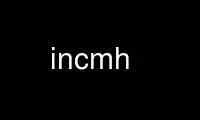
This is the command incmh that can be run in the OnWorks free hosting provider using one of our multiple free online workstations such as Ubuntu Online, Fedora Online, Windows online emulator or MAC OS online emulator
PROGRAM:
NAME
inc - incorporate new mail
SYNOPSIS
inc [+folder] [-audit audit-file] [-noaudit] [-changecur | -nochangecur] [-form formfile]
[-format string] [-file name] [-silent | -nosilent] [-truncate | -notruncate] [-width
columns] [-host hostname] [-port portname/number] [-user username] [-pack file]
[-nopack] [-proxy command] [-sasl | -nosasl] [-saslmech mechanism] [-snoop]
[-version] [-help]
DESCRIPTION
Inc incorporates mail from the user's incoming mail drop into an nmh folder. If the mail
drop is a file, it can be in mbox or MMDF format. If the mail drop is a directory it will
considered to be a Maildir format mail drop.
You may specify which folder to use with +folder. If no folder is specified, then inc
will use either the folder given by a (non-empty) “Inbox” entry in the user's profile, or
the folder named “inbox”. If the specified (or default) folder doesn't exist, the user
will be queried prior to its creation.
When the new messages are incorporated into the folder, they are assigned numbers starting
with the next highest number for the folder. As the messages are processed, a scan
listing of the new mail is produced.
If the user's profile contains a “Msg-Protect: nnn” entry, it will be used as the
protection on the newly created messages, otherwise the nmh default of 0600 will be used
(on filesystems that support it). For all subsequent operations on these messages, this
initially assigned protection will be preserved.
If the switch -audit audit-file is specified (usually as a default switch in the profile),
then inc will append a header line and a line per message to the end of the specified
audit-file with the format:
<<inc>> date
<scan line for first message>
<scan line for second message>
<etc.>
This is useful for keeping track of volume and source of incoming mail. Eventually, repl,
forw, comp, and dist may also produce audits to this (or another) file, perhaps with
“Message-Id” information to keep an exact correspondence history. “Audit-file” will be in
the user's nmh directory unless a full path is specified.
Inc will incorporate even improperly formatted messages into the user's nmh folder,
inserting a blank line prior to the offending component and printing a comment identifying
the bad message.
In all cases, the user's mail drop will be zeroed, unless the -notruncate switch is given.
If the profile entry “Unseen-Sequence” is present and non-empty, then inc will add each of
the newly incorporated messages to each sequence named by the profile entry. Inc will not
zero each sequence prior to adding messages.
The interpretation of the -form formatfile, -format string, and -width columns switches is
the same as in scan.
By using the -file name switch, one can direct inc to incorporate messages from a file
other than the user's maildrop. Note that the name file will NOT be zeroed, unless the
-truncate switch is given.
The -file switch does not support use of standard input. Instead, the rcvstore command
can be used to incorporate mail from the standard input stream.
If the environment variable $MAILDROP is set, then inc uses it as the location of the
user's maildrop instead of the default (the -file name switch still overrides this,
however). If this environment variable is not set, then inc will consult the profile
entry “MailDrop” for this information. If the value found is not absolute, then it is
interpreted relative to the user's nmh directory. If the value is not found, then inc
will look in the standard system location for the user's maildrop.
The -silent switch directs inc to be quiet and not ask any questions at all. This is
useful for putting inc in the background and going on to other things.
Using POP
inc will normally check local mail drops for mail, as covered above. But if the option
“pophost” is set in “mts.conf”, or if the -host hostname switch is given, or if the
$MAILHOST environment variable is set, then inc will query this POP service host for mail
to incorporate. If $MAILHOST is set and -host is specified as well, the commandline
switch will override the environment variable. The -port switch specifies the port name
or number used to connect to the POP server. If unspecified the default is “pop3”.
To specify a username for authentication with the POP server, use the -user username
switch. The credentials profile entry in the mh-profile(5) man page describes the ways to
supply a username and password.
If passed the -proxy command switch, inc will use the specified command to establish the
connection to the POP server. The string %h in the command will be substituted by the
hostname to connect to.
If inc uses POP, then the -pack file switch is considered. If given, then inc simply uses
the POP to packf the user's maildrop from the POP service host to the named file. This
switch is provided for those users who prefer to use msh to read their maildrops.
For debugging purposes, you may give the switch -snoop, which will allow you to watch the
POP transaction take place between you and the POP server.
If nmh has been compiled with SASL support, the -sasl switch will enable the use of SASL
authentication. Depending on the SASL mechanism used, this may require an additional
password prompt from the user (but the netrc file can be used to store this password, as
described in the mh-profile(5) man page). The -saslmech switch can be used to select a
particular SASL mechanism.
If SASL authentication is successful, inc will attempt to negotiate a security layer for
session encryption. Encrypted traffic is labelled with `(encrypted)' and `(decrypted)'
when viewing the POP transaction with the -snoop switch.
Use incmh online using onworks.net services
